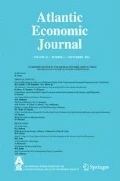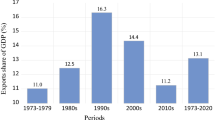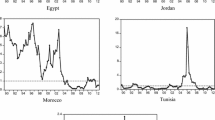Abstract
In 2014, the IMF reported that China became the largest economy in the world according to Purchasing Power Parity rates. This study aims to explain the Chinese economic miracle. It focuses on frequently suggested factors influencing China’s real gross domestic product (GDP), such as export promotion, exchange rate policy, and foreign direct investment (FDI). The paper employs the Bounds test of the autoregressive distributed lag (ARDL) model to test for cointegration. Once cointegration is established, Granger Causality is investigated using the vector autoregressive model and the Toda and Yamamoto (1995) method. Two different combinations of the real macroeconomic variables exports, exchange rate, imports, and FDI were employed to examine Granger causal relationships. All explanatory variables, except for the exchange rate, were found to have plausible relationships with GDP. The exchange rate and GDP relationship was unexpected; a Renminbi appreciation was associated with an increase in GDP. To investigate this paradox, a third ARDL model was estimated with exports as the dependent variable and the exchange rate, world GDP, and FDI as the independent variables. In this model, we found evidence of cointegration and a plausible relationship between real exports and the real exchange rate. Exchange rate devaluation increased exports and thus indirectly increased GDP. Such findings help to resolve the unexpected results. Nonetheless, according to the Granger causality tests the established statistical evidence is rather weak. We found that both the exchange rate and FDI are no longer strong drivers of economic growth in China.

Similar content being viewed by others
Notes
Rein Ming Bi (RMB) translates to “the People’s Currency.”
The optimal lag length of each variable of the ARDL model is found by estimating: (p + 1)k regressions, where k is the number of right-hand variables in the estimated equation and p is the maximum number of lags included for each variable in the single equation ARDL model.
For both Model A and Model B, data for imports and exports come from the China Statistical Yearbook (2015).
The data for population in both Model A and Model B comes from Worldometers (2015).
Data for FDI in real 2010 US dollars come from the World Bank (2016), and are transformed into real 2010 RMB by multiplying by the real ER. We employed the same ER used in Models A and B.
The SIC is known to select fewer lagged differences than any of the other criteria, and as a result, it picks the most parsimonious model. This is desirable for this study, as the sizes of the two samples of Models A and B are relatively small.
This is because all the variables in both models are expressed in terms of their natural logarithms.
Although China has had a fixed exchange rate regime vis-à-vis the U.S. It almost always maintained a fluctuation band, thus It is appropriate to state that the exchange rate devalues or depreciates as both are possible under the Chinese foreign exchange regime.
Within this period the nominal exchange rate appreciated by 17.5% whereas the real exchange rate by 15%.
This was a big setback for policy stabilization purposes, because monetary policy constitutes a powerful tool to cope with shocks in the economy.
The nominal world GDP in US dollars, and the nominal Chinese GDP in U.S. dollars, comes from the World Bank. The GDP deflator index used to transform World GDP into real 2010 U.S. dollars is from the IMF IFS database.
The export data come from the China Statistical Yearbook. The FDI data come from the World Bank. The ER used in Model C is the same as defined in Models A and B.
Unit roots for Model C are available in the only supplementary appendix.
To save space we only report the long-run ECM ARDL model and accompanying cointegration equation.
Toda and Yamamoto showed that even if a set of level variables are of different order of integration, the standard asymptotic theory is still valid, provided the order of integration does not exceed the lag length of the VAR model.
This is the case because none of the probability values are below 0.05.
The tests were carried out with the software EViews and are referred to as: “Granger Causality/Block Exogeneity tests.” in Eviews.
References
Alimi, R. S. (2014). ARDL bounds testing approach to Cointegration: A re-examination of augmented fisher hypothesis in an open economy. Asian Journal of Economic Modelling, 2(2), 103–114.
Chen, Y., Funke, M., & Tao, K. (2015). Financial market reform - a new drive for China’s economic growth? BOFIT Discussion Paper, 5, 3–37.
China Statistical Yearbook (2015) http://www.stats.gov.cn/tjsj/ndsj/2017/indexeh.htm. Accessed February 17, 2017.
DeJong, D. N., Nankervis, J. C., Savin, N. E., & Whiteman, C. H. (1992). Integration versus trend stationarity in time series. Econometrica, 60(2), 423–433.
Dickey, D. A., & Fuller, W. A. (1979). Distribution of the estimators for autoregressive time series with a unit root. Journal of the American Statistical Association, 74(366a), 427–431.
Elliott, G., Rothenberg, T. J., & Stock, J. H. (1996). Efficient tests for an autoregressive unit root. Econometrica, 64, 813–836.
Engle, R. F., & Granger, C. W. (1987). Co-integration and error correction: Representation, estimation, and testing. Econometrica: Journal of the Econometric Society, 55, 251–276.
Federal Reserve Economic Data (2016) https://fred.stlouisfed.org/. Accessed October 14, 2017.
International Monetary Fund (2016) International Financial Statistics Database http://data.imf.org/?sk=4C514D48-B6BA-49ED-8AB9-52B0C1A0179B&sId=1409151240976. Accessed October 14, 2017.
Jalil, A., Feridun, M., & Ma, Y. (2010). Finance-growth nexus in China revisited: New evidence from principal components and ARDL bounds tests. International Review of Economics and Finance, 19(2), 189–195.
Johansen, S. (1991). Estimation and hypothesis testing of cointegration vectors in Gaussian vector autoregressive models. Econometrica: Journal of the Econometric Society, 59, 1551–1580.
Johansen, S. (1995). Likelihood-based inference in cointegrated vector autoregressive models. New York, NY: Oxford University Press.
Kawai, M., & Pontines, V. (2014). The Renminbi and Exchange Rate Regimes in East Asia. ADBI Working Paper, 484, 1–36. https://papers.ssrn.com/sol3/papers.cfm?abstract_id=2443659. Accessed April 18, 2017.
Liu, X., Burridge, P., & Sinclair, P. J. (2002). Relationships between economic growth, foreign direct investment and trade: Evidence from China. Applied Economics, 34(11), 1433–1440.
Narayan, P. K. (2005). The saving and investment nexus for China: Evidence from cointegration tests. Applied Economics, 37(17), 1979–1990.
Narayan, P. K. (2006). Examining the relationship between trade balance and exchange rate: The case of China's trade with the USA. Applied Economics Letters, 13(8), 507–510.
Ng, S., & Perron, P. (2001). Lag length selection and the construction of unit root tests with good size and power. Econometrica, 69(6), 1519–1554.
Organization for Economic Cooperation and Development statistics (2017) http://stats.oecd.org/. Accessed February 17, 2017.
Pesaran, M., & Shin, Y. (1999). An autoregressive distributed lag modelling approach to cointegration analysis. In S. Strom (Ed.), Econometrics and Economic Theory in the 20 th Century: The Ragnar Frisch Centennial Symposium (chapter 11). Cambridge: Cambridge University Press.
Pesaran, M. H., Shin, Y., & Smith, R. J. (2001). Bounds testing approaches to the analysis of level relationships. Journal of Applied Econometrics, 16(3), 289–326.
Phillips, P. C., & Perron, P. (1988). Testing for a unit root in time series regression. Biometrika, 75(2), 335–346.
Popescu, G. H. (2013). The social evolution of China's economic growth. Contemporary Readings in Law and Social Justice, 5(1), 88.
Prasad, E., & Zhang, B. (2014). Monetary Policy in China. In Fan, S., Kanbur, R., Wei, S. J., & Zhang, X. (Eds.), The Oxford Companion to the Economics of China (chapter 29). New York, NY: Oxford University Press.
Toda, H. Y., & Yamamoto, T. (1995). Statistical inference in vector autoregressions with possibly integrated processes. Journal of Econometrics, 66(1), 225–250.
World Bank Database (2016) https://data.worldbank.org/. Accessed December 15, 2017.
Worldometers statistics (2015) China Population http://www.worldometers.info/world-population/china-population/. Accessed February 14, 2017.
Xu, Y. (2000). China's exchange rate policy. China Economic Review, 11(3), 262–277.
Yao, S. (2006). On economic growth, FDI and exports in China. Applied Economics, 38, 339–351.
Zestos, G. K., & Tao, X. (2002). Trade and GDP growth: Causal relations in the United States and Canada. Southern Economic Journal, 68, 859–874.
Zestos, G. K., Taylor, T. K., & Patnode, R. D. (2016). Causality within the euro area?: Trade surplus in the north versus public debt in the south. Journal of Economic Integration, 31, 898–931.
Zhang, J. X. (2015). Is China's economic growth sustainable?: A general equilibrium analysis. The Journal of Developing Areas, 49(4), 407–414.
Zhang, X. P., & Cheng, X. M. (2009). Energy consumption, carbon emissions, and economic growth in China. Ecological Economics, 68(10), 2706–2712.
Zhou, Q. (2010). The institutional foundation of China's economic growth. China Economic Journal, 3(1), 25–32.
Acknowledgements
We express our gratitude to Hunter Simons for excellent research assistance. We also thank Christopher Newport University and the chair of the Department of Economics, Dr. Robert Winder. Particularly we thank the Dean of Social Sciences, Dr. Robert Colvin, for his continuous support. Finally, we thank Dr. Roark Mulligan for his constructive criticism.
Author information
Authors and Affiliations
Corresponding author
Electronic supplementary material
ESM 1
(DOCX 295 kb)
Rights and permissions
About this article
Cite this article
Zestos, G.K., Guo, W. & Patnode, R. Determinants of Real Chinese GDP 1978–2014. Atl Econ J 46, 161–177 (2018). https://doi.org/10.1007/s11293-018-9580-z
Published:
Issue Date:
DOI: https://doi.org/10.1007/s11293-018-9580-z




